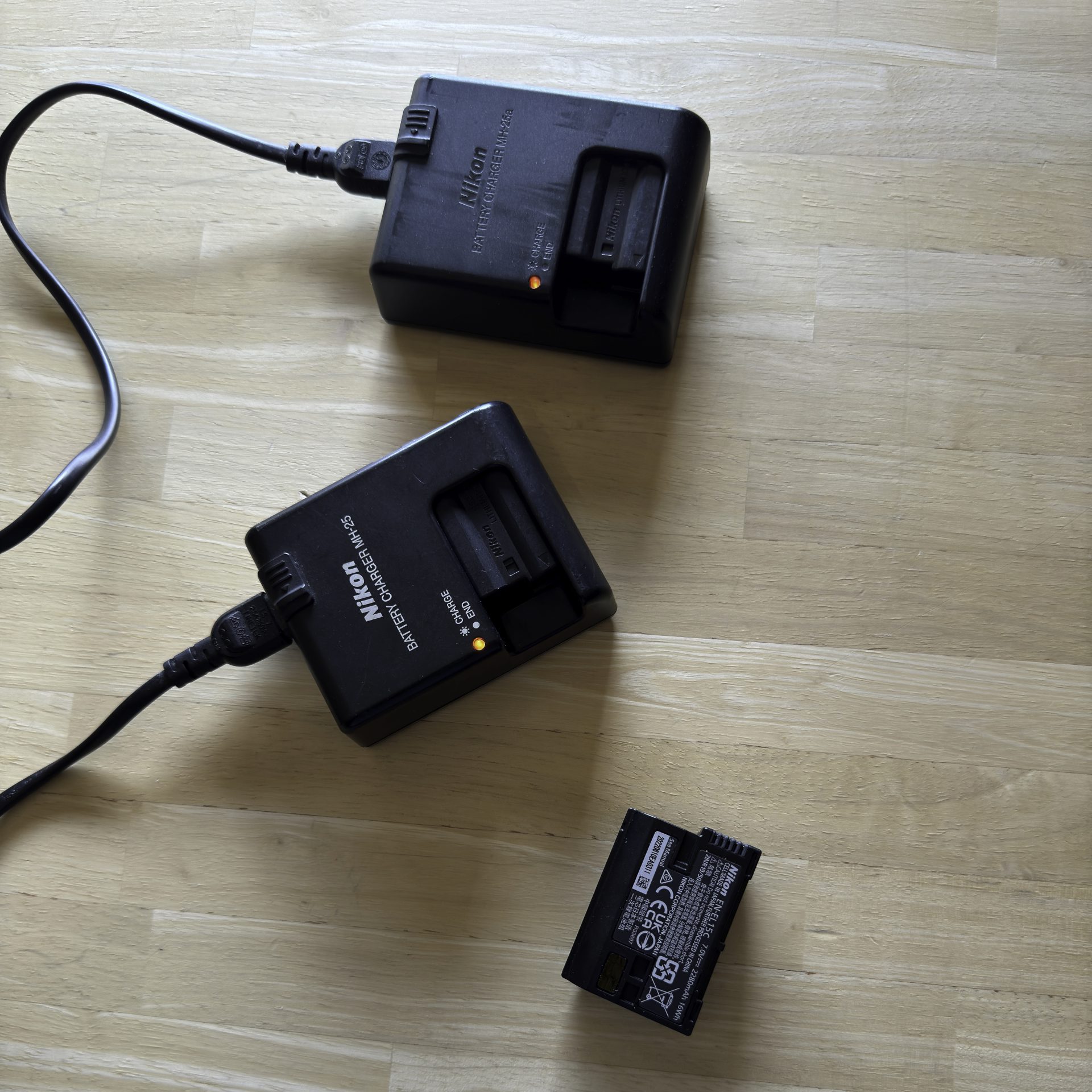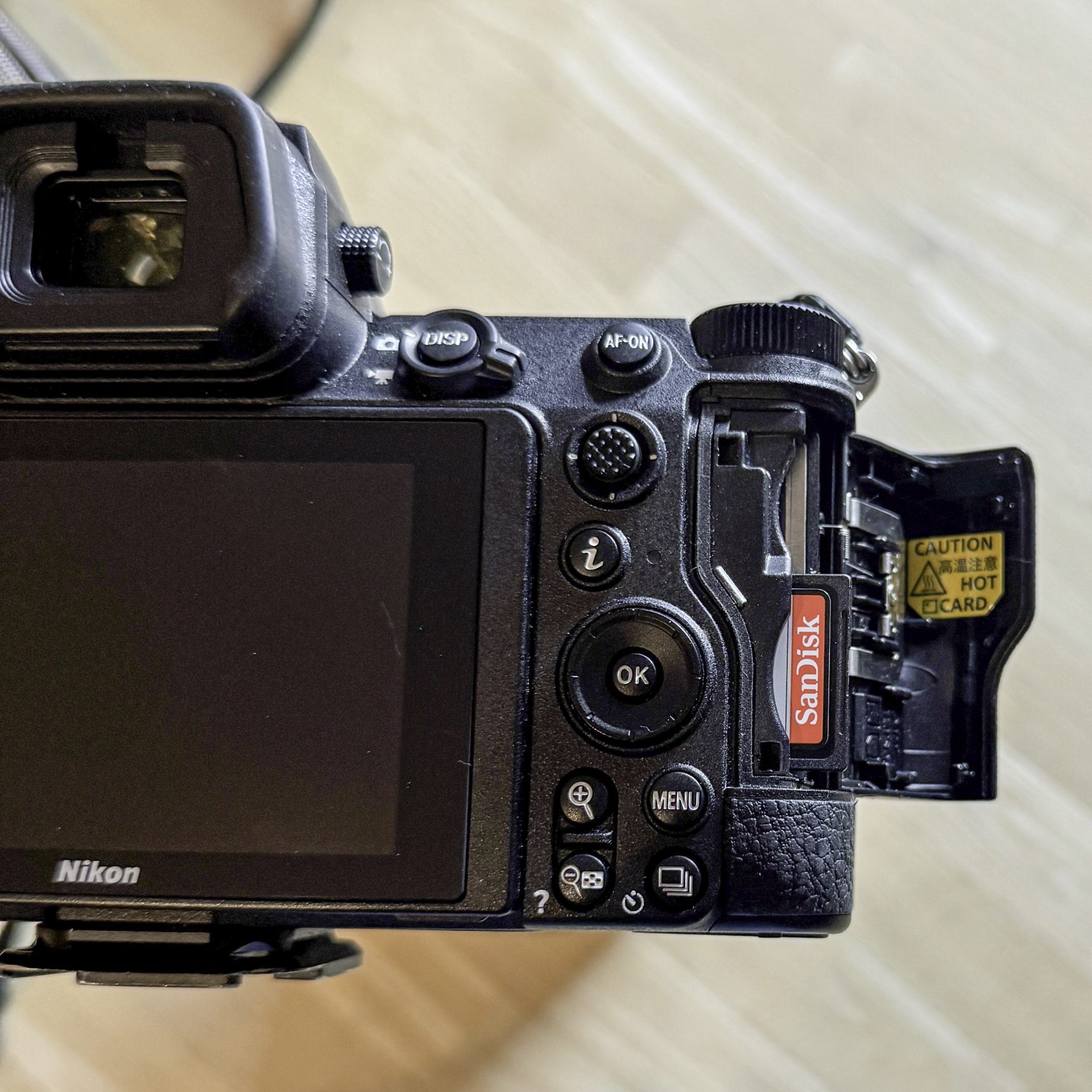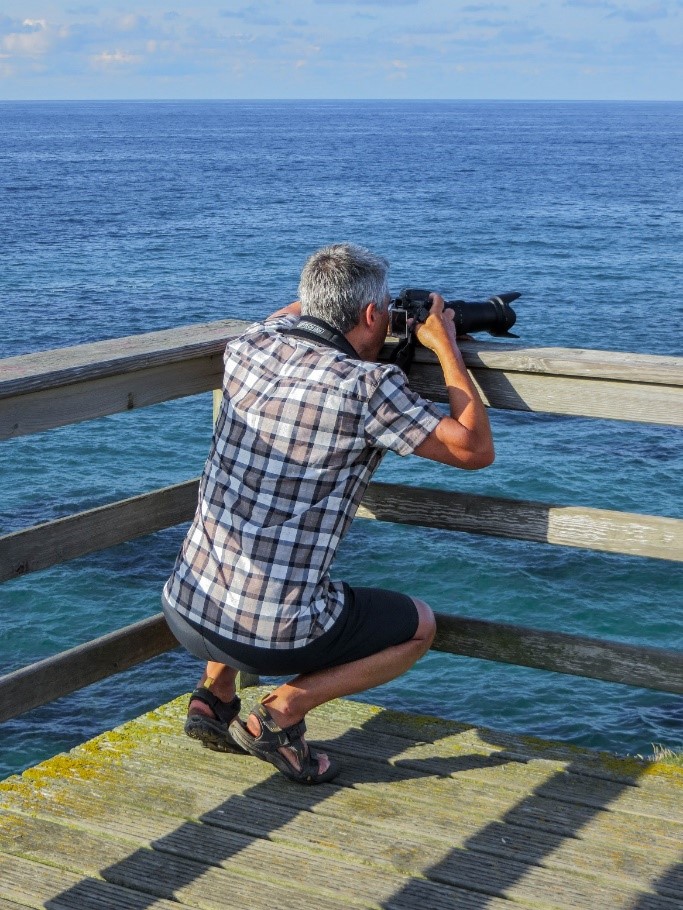Today, we will delve into a quick blog about common ‘silly mistakes’ landscape photographers can make. I call them silly mistakes because, with the proper preparation, they could have been easily avoided. I must admit that I’ve made my fair share of these mistakes, but I’ve also learned a lot from sharing experiences with other photographers.
1. Don’t forget to charge your battery
▪ What goes wrong? Picture this: you’re in a stunning location, all set to capture the perfect shot, and your camera abruptly shuts down due to a dead battery. This leads to frustration and the potential loss of a unique opportunity.

Don’t forget to remove your battery from the charger when you leave!
How to avoid it. Always check that your battery is fully charged before every shoot. Invest in an extra battery and make sure you always have it handy. A charged spare battery can be your salvation during longer shoots.
2. No memory card in the camera
▪ What goes wrong? I think we all encounter this one from time to time. Imagine you arrive on location, and what turns out is that the memory card is not in your camera but still in the card reader at home. Worst of all, you don’t have a spare card in your bag.
▪ How to avoid it. You might say not to use a card reader but a camera when transferring photos. But a card reader is more accessible and, above all, much faster. Moreover, it does not take up the camera. So always try to put spare cards in your camera bag. I use Sandisk-128gb-compact-flash-express-extreme memory cards, among others
3. No backup memory card
▪ What goes wrong? You’re in a shoot, and suddenly, your camera signals that the memory card is full, or worse, the card becomes corrupted. Without a backup, this can significantly disrupt your day.

Always check before you leave that your device has an effective memory card.
How to avoid it: Always carry several memory cards. Use cards with enough storage space and change them occasionally during the shoot to avoid any risk.
4. Did not bring the camera
▪ What goes wrong? You’re all geared up for the trip, with everything neatly packed in your backpack: tripod, filters, lenses. But in the rush, you forget the most crucial item, your camera. This can be especially painful if you realise it is far from your starting point.
▪ How to avoid it: Make a mental list before you leave and check that you have everything on hand. I’ve had it happen before, but then I turned it into a learning experience by obliging myself to take a series of photos with my smartphone as a challenge. Dealing with some limitations can be fun and educational. Under normal circumstances, I don’t go out without my Nikon Z7-II camera.
5. Setting incorrect exposure
▪ What goes wrong? Overexposed photos often have blown-out highlights, while underexposed images lack much detail in the shadows. This can be incredibly frustrating if you don’t immediately realise the exposure is wrong.
▪ How to avoid it. Learn to properly use your camera’s exposure meter and check the histogram after taking a picture. This will give you a better idea of how the exposure is distributed. You can also use bracketing, taking several shots with different exposures to choose the best one later. If you are inexperienced or unsure about the right setting, learning a bit about the exposure triangle (aperture, shutter speed, ISO) is recommended.
6. Forgetting the tripod
▪ What goes wrong? The slightest movements can cause blur, especially at long shutter speeds, such as night photography or low-light landscapes. Without a tripod, it is almost impossible to get sharp images.

Photo left: Difference between a regular tripod and a travel tripod. And photo right: at work without a tripod
How to avoid it. Always carry a sturdy tripod if you plan to use long shutter speeds. This also applies when shooting with heavy telephoto lenses. If the tripod seems too big or heavy, there are compact and lightweight alternatives you can consider. You can also place your camera on your rolled-up jumper on a wall or rock in front of you.
7. Using the wrong lens
▪ What goes wrong? A common mistake is using an inappropriate lens for the situation. For example, a telephoto lens for a vast landscape can limit the scene’s beauty.
▪ How to avoid it. Choose the right lens for the subject and situation. A wide-angle lens is perfect for landscapes, while a telephoto lens works better for close-ups. Try experimenting with different lenses to choose the right one for each scenario. I usually have a lightweight lens. Nikon-z-24-200mm-f-4-5-6-3-vr lens on my full-frame camera.
8. Poor composition
▪ What goes wrong? A poorly constructed photo can completely ruin an otherwise great shot. Think of a crooked horizon, distracting objects in the background, or a subject awkwardly placed in the frame.
▪ How to avoid it. Apply the “rule of thirds” to frame your subject naturally. Set your horizon at the right height and keep the composition balanced. Always consider the background and avoid distracting elements.
9. Forgot to adjust the ISO setting
▪ What goes wrong? Too high an ISO can lead to noise in your photos, while too low an ISO requires unnecessarily slow shutter speeds. This can be especially problematic if you don’t regularly adjust ISO to changing light conditions.
▪ How to avoid it. Check your ISO settings before you start shooting. Remember that a low ISO produces better image quality, but you may need a tripod in low-light situations. Adjust the ISO based on the lighting conditions. In very bright conditions, set the ISO as low as your camera will allow; if it gets a bit darker, such as in a dense forest, be sure to increase the ISO or work only on a tripod.
10. No attention to background
▪ What goes wrong? Often, the focus is only on the main subject, while the background is full of distracting elements. This can be distracting and reduce the impact of your photo.
▪ How to avoid it. Always look at what is happening behind your subject. Try to choose a calm background that does not distract from the subject. A wide aperture (such as f/2.8) can sometimes blur the background, making distracting elements invisible.
11. Forgot to clean the lens
▪ What goes wrong? Dirt, dust or fingerprints on your lens can cause blurred images or create weird smudges due to lens flare.
▪ How to avoid it. Make it a habit to clean your lens regularly, especially before you start a shoot. Use a lens cloth or a special pen to gently clean the lens without damaging it. Splashes on the lens are more frequent than you might think. However, also check that there are no spots on your sensor. It might also be time to clean or have your sensor cleaned. This should, of course, be done with care.
12. Being too dependent on automatic settings
▪ What goes wrong? Automatic modes are convenient but give you little control over the creative aspects of photography. As a result, your photos can look flat or predictable.
▪ How to avoid it. Learn your camera’s manual settings, such as aperture, shutter speed, and ISO. Shooting manually gives you complete control over your image’s appearance and makes you more creative.
13. Forgetting to shoot RAW
▪ What goes wrong? JPEG files have fewer post-processing capabilities than RAW files, meaning you have less control over exposure, colour, and detail in post-production.
▪ How to avoid it. Shoot in RAW format as much as possible. This gives you maximum flexibility in post-processing and ensures you retain the complete image information. The downside is that you get larger files and still require some post-processing.
14. Wrong white balance
▪ What goes wrong? Incorrect white balance settings can lead to photos with an unwanted colour cast, e.g. bluish in shade or orange in artificial light.
▪ How to avoid it: Learn your camera’s white balance settings and adjust them manually depending on the type of light you are shooting in. Shoot in RAW to easily adjust the white balance later without losing quality.
15. Sloppy post-processing
▪ What goes wrong? Too much contrast, oversaturation or extreme filters can make a photo artificial and unrealistic. A lack of attention to detail, such as noise reduction or colour balance, can also spoil the final result.
▪ How to avoid it. When post-processing, always keep the original in mind. Try to make subtle adjustments and work in small steps. Shoot in RAW format so you have more flexibility in post-processing without losing image quality. If you find Photoshop and Lightroom too expensive or complex, try Luminar Neo from Skylum.
16. Insufficient preparation
▪ What goes wrong? Without preparation, you can run into unexpected problems on location, such as bad light, inaccessible terrain, or time constraints, which can result in sub-optimal photos.
▪ How to avoid it: Always research the location beforehand. Look at the weather forecast and the best times of day for light, and plan your compositions if possible. Make sure your equipment is in complete working order before you leave.
By paying attention to these common mistakes and their solutions, you can take your photography to the next level and develop a more professional approach.
What is the biggest mistake you have ever made during a shoot? Share your experiences in the comments and help others learn from your experience!
Leave a reply